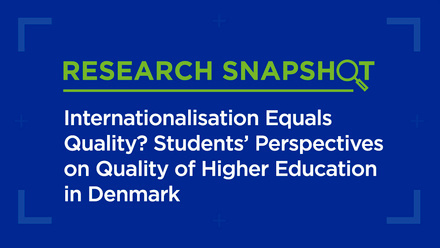The European Universities Initiative: Delivering on the wider vision?

Transnational collaborative partnerships are not a new phenomenon; many higher education institutions in Europe and beyond are part of such border-spanning institutional arrangements expecting a plethora of academic, economic, political and socio-cultural benefits. Yet, when it comes to transnational cooperation in higher education in the European Union, the European Universities Initiative (EUI) is the new game in town.
The EUI was launched in 2019 with the ambition to spark a full transformation of participating higher education institutions (HEIs) and the European higher education landscape as a whole, by elevating selected alliances to be key change agents in this next Copernican revolution. To what extent are European Universities managing to deliver on this ambitious vision?
A question of perspective
This rather simple question has no easy answer. It depends on many factors, including the lens through which the question is looked at. From a European perspective, the enquiry would focus on whether the initiative delivered on its initial political ambitions, which can hardly be decoupled from the alliances’ and member HEIs’ specific, varying and multiplying goals. From a national perspective, the enquiry would rather need to focus on the centrality of participating in the EUI for national HEIs, for their own internal transformation as well as for a system-level transformation (ie the much-anticipated spillover effects to other HEIs not participating in this type of alliances). And third, from an institutional perspective, the focus would be on the effect of alliance participation for advancing HEIs’ internationalisation agenda and institutional transformation, to the envisioned extent and at the expected pace.
Without claiming to provide a comprehensive picture for the three main dimensions above, this blog showcases results and observations from two comparative initiatives – one initial assessment of the EUI at European level and one support project conducted in Czechia, namely 'Monitoring Internationalisation of Czech Higher Education – MICHE (2021-2022)' – detailing progress, lessons learnt and ways forward. The post builds on a related presentation delivered by the authors at the 2023 EAIE Conference in Rotterdam.
Different levels of centrality and engagement are likely to lead to different concrete benefits
The wider vision of the EUI is to accelerate "the transformation of higher education institutions into the universities of the future with structural, systemic and sustainable impact". Thus, understanding the achievements of the initiative and the challenges it faces in reaching its aspirations to transform the European higher education sector is relevant not just to alliance members but to the higher education sector as a whole.
State of play in 2023
The EUI is hailed as a "flagship initiative of the European strategy for universities" and "a key pillar of the European Education Area". Its ambitions are broad and aim at seemingly paradoxical policy goals, such as fostering both excellence and inclusion in European higher education, or simultaneous deepening and widening of cooperation. Five years after the launch of the first call for applications, 50 European University alliances with more than 400 higher education institutions from 35 Erasmus+ partner countries (including all 27 European Union Member States) are taking part in the initiative. The recently published fifth – and possibly last – Erasmus+ call for proposals underscores the ambition of the European Commission to expand the initiative to at least 60 alliances that pursue "deep institutional transnational cooperation", involving up to 500 HEIs in Europe.
Balancing excellence and inclusion
Award criteria and procedures have remained quite stable over the five Erasmus+ calls for establishing and expanding alliances. Yet, the characteristics of the institutions that are part of selected alliances have changed across calls. The institutions selected in the first round are on average older, larger in terms of student numbers, and more comprehensive than those selected in the following rounds. The award criterium for geographical diversity in the composition of the alliances has led to a good coverage of all EU regions into the initiative.
In time, the European Universities Initiative is becoming more representative of the European higher education landscape. The selected HEIs in the first three calls of the EUI cover around 10% of all institutions estimated by the European Commission to be in the European Education Area (EEA), including at least 36% of enrolled students in Bachelor’s and Master’s studies, and over 50% of doctoral students. Still, if we examine the results of the first three calls, there are significant differences between participating and non-participating institutions in the European Universities Initiative. Higher education institutions that are part of selected alliances have significantly higher numbers of academic staff, engage significantly more in research and education especially at the MA level, are less oriented towards social sciences and humanities, and host significantly more international students pursuing both degree and short-term mobility. Looked at from a national perspective, like in Czechia, early ‘adopters’ were the HEIs with a long track record and capacity for international cooperation.
Realising transnational cooperation benefits
Emerging studies and stakeholder insights on the benefits brought by European University alliances show that, despite the challenges to transnational cooperation brought about by COVID-19, students and staff enjoy increased rates of (blended) mobility and engagement with big societal challenges. Participating institutions enjoy improved quality of teaching, increased visibility, improved reputation, and access to platforms for sharing and developing good practices of transnational cooperation. At the sector level, the whole-institution approach to transnational cooperation promoted by the initiative helps to identify and eliminate obstacles to collaboration. More research is needed to establish which of the self-reported benefits are significant and can be attributed to alliance membership.
Additionally, it must be recognised that the centrality that the alliance participation plays for individual HEIs varies, and so will the benefits that the respective institutions can draw from their participation. Taking Czech HEIs as an example, and certainly not an exception, those for whom the alliance is "the main tool/channel" to advance their internationalisation ambitions, and that allocate additional resources for their participation, will likely see different benefits materialise, compared to those for whom this form of cooperation is less important (having the status of "one of the main tools", along other pre-existing partnerships, or being regarded, particularly by institutional leadership, as "just another project"). This shouldn’t be interpreted though as a general call to reorient more institutional and national resources towards alliances, but simply as an observation that different levels of centrality and engagement are likely to lead to different concrete benefits.
Achieving structural, systemic and sustainable impact
The EUI also aspires to have a positive impact beyond the participating HEIs and alliances, aiming to deliver on the wider vision of deep structural change at system level in a sustainable manner. While the initiative has enabled discussions about national-level reforms and has brought some changes in national regulation to facilitate transnational cooperation, alliances are still facing challenges.
It is important to ensure that regulatory changes do not lead to further fragmentation – rather than harmonisation – between higher education systems
The most significant challenges are policy and funding related. Despite the Bologna Process, which aims at harmonising higher education systems to enable cooperation, there is still diversity in existing national regulatory frameworks. Inconsistencies between quality assurance systems, degree recognition or national qualifications frameworks, bring about additional hurdles for the much deeper form of cooperation foreseen between alliance members. In addition, initial uncertainties about the future developments and longevity of the EUI have pushed alliances into a project logic rather than a long-term cooperation model. This has been exacerbated by the unsuitability of the initial funding model which required substantial additional (co-)funding for pursuing the ambitious aims of the initiative. The different levels of support that institutions got from public sources and the differences in financial capacity between alliance members make it difficult for them to align their expectations and goals.
The intended long-term transformation processes need regulatory and financial support. Yet, it is important to make progress towards identifying the real costs alliances incur and ensuring that regulatory changes do not lead to further fragmentation rather than harmonisation between higher education systems. These support mechanisms should also not create unfair advantages that only benefit HEIs that are part of alliances; a fast-track for alliances only would not help with the system-level transformation, long-term, and that applies to both regulatory changes and (earmarked) funding. Only then will the European Universities Initiative be able to deliver on its wider vision.
Outlook
So, is the European Universities Initiative delivering on the wider vision? Yes – to date, it partly does, although the level of ambition at European level widens with every new policy document and adjacent initiatives. While the ambitions for spillover effects and system-level transformation were there from the start, a specific and reasonable timeline for that was never defined at political level. This led to the mislead expectation that this spillover would materialise almost overnight, although clearly most of the envisaged innovative models and internal institutional transformations need time to concretise, and a more comprehensive, multi-lens and longitudinal outlook is needed.
Is the EUI delivering on the wider vision? Yes – to date, it partly does
The upcoming Monitoring Framework for the EUI, currently under development, is likely to be able to contribute with part of this encompassing picture, by looking qualitatively and quantitatively, as well as comparatively (with other forms of transnational cooperation respective HEIs are part of) at the specific cooperation benefits of the initiative, as a whole. In parallel, different Member States are starting to look, in various forms, into the relevance of the initiative from a national, system-level perspective, facilitating peer-learning.






